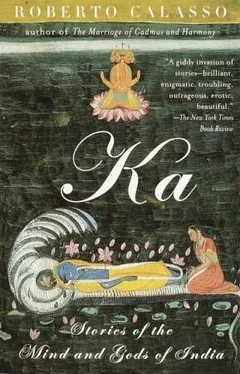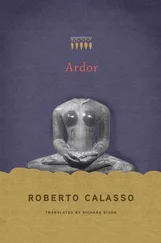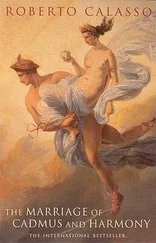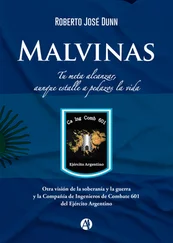Viṣṇu’s belly was bare, burnished. One day a lotus stalk sprouted from his navel. That stalk belonged to him, just as much as his pink nails. It had the same porosity as his skin. It grew from his body, up to its flower. Everything else was a consequence. With something incongruous and disconnected about it, like all consequences, like all worlds, forgetful of their origin.
An unexpected excess of sattva , of “being”—like a shove, a spurt, a sigh — awoke the young Viṣṇu as he drifted in silence, aimlessly. It was enough to let him see that the world was empty. Again that nameless thrust. Amazed, eyes half closed, Viṣṇu realized that a stalk had grown in the void. Where from? He looked down, following the stalk. Then Viṣṇu saw that that strange filament, upright and slightly curved, was sprouting from his navel. His eye followed it up to where, at the top, lotus petals were opening to the sky. And there, sitting on the corona, he caught sight of Brahmā with his four heads, looking puzzled. He too was gazing around, like a ship’s topman. And he could only confirm that the world was indeed empty. Except for that body supine on the waters, whence arose — Brahmā thought — his own delicate, hanging abode. Viṣńu and Brahmā ignored each other, each believing he was everything.
Brahmā said: “Interrupting a deep sleep is like interrupting two lovers in their coitus.” The world begins with the interruption of a sleep. Which is why wakefulness is the only proof of existence. And why the world is fragmented and cannot achieve fullness. And why it constantly seeks to reconstruct fullness. In vain, because the discontinuous will never pass over into the continuous. Mathematics tells us that, last outpost of all that is.
The watery expanse was endless in all directions. Only in one remote point could something be seen rising from it. Getting closer, you could make out a tree, but so thick and huge as to look like a mountain. Hidden among its branches, which formed an enameled pavilion, Garuḍa awoke. In his claws he held hymn number 121 of the tenth book of the Ṛg Veda. His eye settled on the very syllable from which everything had issued forth. Ka. But when had that happened? And was it still happening? A moment ago, or in another aeon? The rest followed from it. And then the same question came back: who is who? He lifted his beak, sucked in the air that filtered through the foliage. Once again it was time to take flight.
A Note on Sanskrit Pronunciation

The vowels are given their full value, as in Italian, with the exception of the short a , which is more like the u in but . Thus long ā is pronounced like the a in father, i as in fit, ī as in machine, u as in put, ū as in rule, e as in the Italian nero, o as in the Italian tenore, ai as i in bite, au as ou in found. Ṛ and ḷ are also vowels and are generally pronounced as r followed by a very short i or u , somewhat like re in pretty ; and as le in little , or in the French table .
The aspiration of the aspirated consonants should be heard distinctly. Thus th and ph must never be pronounced as in English thin and telephone , but as in hothouse and upheaval. The same for kh, gh, ch, jh, ṭh, ḍh, dh, bh. G is sounded as in get , and ṅ as n in king; c is similar to ch in church , and j is pronounced as in join. Ñ sounds like n in punch , but the combination jñ may be pronounced somewhat like dny or gny. The difference between the retroflex t, ṭh, ḍ, ḍh, ṇ and the dentals t, th, d, dh, n is that the former set is pronounced with the tongue turned rather back along the palate, while the latter is produced by bringing the tip of the tongue against the very edge of the front teeth. S sounds like s in sin, ṣ like sh in shun , while ś is something midway between the two.
Ḥ is in India generally pronounced as a hard h followed by a faint echo of the preceding vowel, while ṃ is a nasalization of the preceding vowel, rather in the way some French vowel sounds are nasalized. The stress is laid ou a long penultimate (Kālidása), on the antepenultimate when followed by a short syllable (Himálaya, Gótama), and on the fourth from the end when two short syllables follow (kárayati) . A syllable is long if it contains a long vowel ( ā, ī, ū, e, o, but also ai and au ), or a vowel followed by more than one consonant. It should be noted that the aspirated consonants are considered single consonants in the Sanskrit alphabet. In a few words which are typically Vedic the musical accent called udātta has been marked. This stress, which consisted in a higher pitch of the voice, has disappeared in Classical Sanskrit.

Abhimanyu
Son of Arjuna and Subhadr
ā
; marries Uttar
ā
Aciravat
ī
River in the Bihar region
adharma
Disorder, illegality, illegitimacy, violation of
dharma
adhvaryu
Chief priest of proceedings, one of four basic kinds of officiants in the sacrifice of the
soma
; the others are the
hotṛ
, the
udgātr
, and the
brahmān
The priest who, more than any other, performs the liturgical actions; he moves around continually, handles the sacrificial implements, cooks the oblations, tends the fire. “The
adhvaryu
is the eye of the sacrifice” (
Bṛhad Āranyaka Upaniṣad
, 3.1.4)
Ā
ḍ
i
A demon hostile to
Ś
iva
Aditi
Boundless, She who loosens bonds; mother of the
Ā
dityas through her union with Ka
ś
yapa
Ā
dityas
The twelve sons of Aditi and Ka
ś
yapa: Vi
ṣ
ṇ
u, Indra, Vivasvat, Mitra, Varu
ṇ
a, P
ū
ṣ
an, Tva
ṣ
ṭ
ṛ
, Bhaga, Aryaman, Dh
ā
t
ṛ
, Savit
ṛ
, A
ṃ
ś
a
Agastya
A
ṛṣi
born with Vasi
ṣ
ṭ
ha from the bowl where Mitra’s and Varu
ṇ
a’s sperm fell; sometimes considered one of the Saptar
ṣ
is, husband of Lop
ā
mudr
ā
Age of the Losing
Throw
Kaliyuga
Agni
Fire
agnīdh
He who lights the fire; an officiant who tends the fire
agnihotra
Offering to the fire; the simplest and most important of the solemn rites. The head of every family of the three upper castes must offer this sacrifice all his life, morning and evening, shortly before the rising of the sun or the appearance of the first star
agre
Forward; Agni’s secret name
Ahaly
ā
Unplowable One; wife of the
ṛṣi
Gotama
aham
I
āhavanīya
Fire into which one pours the offering; one of the three sacrificial fires, together with the
Читать дальше














